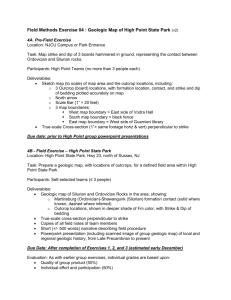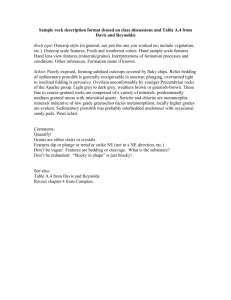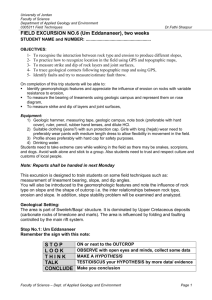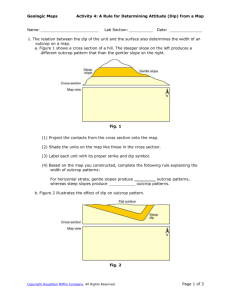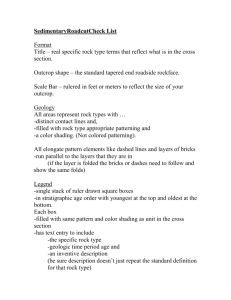Understanding the relationship between the outcrop
advertisement
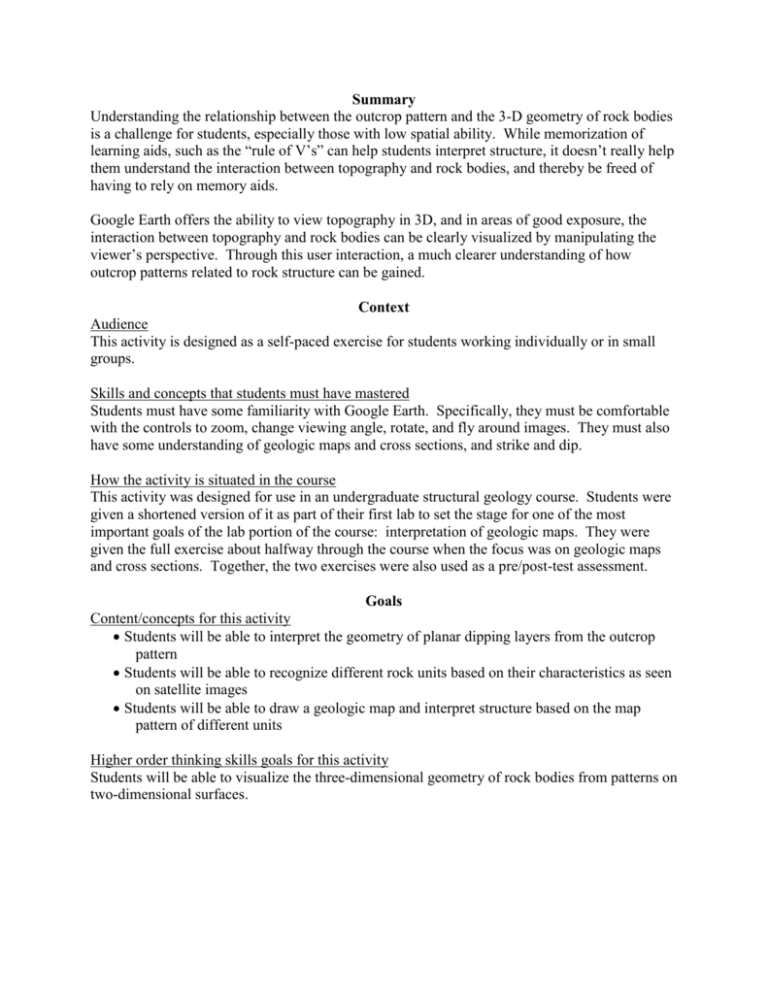
Summary Understanding the relationship between the outcrop pattern and the 3-D geometry of rock bodies is a challenge for students, especially those with low spatial ability. While memorization of learning aids, such as the “rule of V’s” can help students interpret structure, it doesn’t really help them understand the interaction between topography and rock bodies, and thereby be freed of having to rely on memory aids. Google Earth offers the ability to view topography in 3D, and in areas of good exposure, the interaction between topography and rock bodies can be clearly visualized by manipulating the viewer’s perspective. Through this user interaction, a much clearer understanding of how outcrop patterns related to rock structure can be gained. Context Audience This activity is designed as a self-paced exercise for students working individually or in small groups. Skills and concepts that students must have mastered Students must have some familiarity with Google Earth. Specifically, they must be comfortable with the controls to zoom, change viewing angle, rotate, and fly around images. They must also have some understanding of geologic maps and cross sections, and strike and dip. How the activity is situated in the course This activity was designed for use in an undergraduate structural geology course. Students were given a shortened version of it as part of their first lab to set the stage for one of the most important goals of the lab portion of the course: interpretation of geologic maps. They were given the full exercise about halfway through the course when the focus was on geologic maps and cross sections. Together, the two exercises were also used as a pre/post-test assessment. Goals Content/concepts for this activity Students will be able to interpret the geometry of planar dipping layers from the outcrop pattern Students will be able to recognize different rock units based on their characteristics as seen on satellite images Students will be able to draw a geologic map and interpret structure based on the map pattern of different units Higher order thinking skills goals for this activity Students will be able to visualize the three-dimensional geometry of rock bodies from patterns on two-dimensional surfaces. Description of Activity Start by opening Atlas.kmz in Google Earth. Make sure that Terrain is checked and that the elevation exaggeration (Tools/Options) is set to 3. Double-click the file folder in the Places list to bring you to the Atlas Mountains. Expand the folder list if it is not already so. Take a few minutes to acquaint yourself with the fantastically well-exposed geology of the region by moving around, zooming-in on areas of interest, rotating the view, and changing the angle of tilt. Activity I – relationship between outcrop pattern and planar structure Double-click on the Outcrop Ia placemark. Zoom in to about 10 miles eye elevation (found at bottom right corner of screen). This area is underlain by non-marine sedimentary rocks with distinctly different colors. The topography is moderately rugged with ridges of relatively resistant rocks cut by numerous washes and gullies. Note the pattern of “V’s” in the color bands where the gullies cross the rock units. Note the direction of stream flow by looking at the branching pattern of the tributaries (tributaries merge in the downstream direction except on alluvial fans where they diverge downstream) 1. Does the “V” in the color band point upstream or downstream? 2. Can you tell the direction of dip of bedding in the rock units? What is it? Zoom in to about 20,000 ft elevation. Tilt the view to a low angle and rotate it around to different positions. 3. What is the dip direction of bedding? Tilt the scene back to vertical and reexamine the pattern of “V’s”. You may want to go back and forth between tilted and vertical a few times. 4. Describe the relationship between the direction of the “V” and the dip direction. Double-click on the Outcrop Ib placemark. Follow the same steps as above to determine the dip direction. 5. What is the dip direction of the bedding? 6. Describe the relationship between the direction of the “V” and the dip direction. Double-click on the Outcrop Ic placemark. Examine the area by zooming, tilting, and rotating. 7. What is different about the pattern of rock units in this area compared to the previous two areas? 8. What is the dip of bedding? 9. How would you describe the relationship between the outcrop pattern and bedding dip here? 10. Compare this area to the patterns at Outcrop Id. What is the difference? Examine the area around the Outcrop Ie placemark paying particular attention to the feature crossing the area from NE to SW. 10. Describe the outcrop pattern of this feature as it crosses the hills in the center of the area. 11. What is the dip of this feature? 12. Speculate on the origin of this feature? Activity II – relationship between outcrop pattern and folded rocks Double-click on the Outcrop II placemark. Examine the area by zooming, tilting, and rotating. Follow any of the distinctive units and note the general pattern. 1. How does the outcrop pattern in this area differ from those in previous areas (at the same level of zoom)? 2. Zoom-in and determine the dip direction at several places in the area. Are they the same? Is there a pattern to the dip directions? 3. Describe the structure in this area. Activity III – dip slopes Double-click on the Outcrop III placemark. Examine the area by zooming, tilting, and rotating. You are looking at a large dip slope, which is where the ground surface coincides with a single bedding plane. 1. What is the dip direction of bedding? 2. What could explain the distinctive pattern on the prominent dip slope? Activity IV – recognizing different rock types Double-click on the Outcrop IV placemark. Examine the area by zooming, tilting, and rotating. 1. Compare the appearance of the rocks near the placemark with that of the rocks along the edges of this structure Are these all the same rock types (i.e., igneous, sedimentary, metamorphic)? 2. Which rock types are found at each placemark? Activity V – constructing a geologic map and cross section Construct a geologic map and cross section of each of the three areas (polygons), Area 1, Area 2, and Area 3. For your base map, print the view filling the page as much as possible with the polygon. For each area, draw several contacts using the most distinctive units. Place strike and dip symbols at several places within the area to show the orientation of bedding. Sketch a cross section along the line in each polygon. Summary reflection 1. Describe how the outcrop pattern on a geological map can be used to determine the three-dimensional structure. 2. What characteristics can be used to differentiate rock units on a satellite image? Are there any specific to igneous, metamorphic, or sedimentary rocks? Assessment The learning goals can be assessed by having the students use Google Earth to look at other mountain belts (e.g., Zagros region in Iran). Students should also be given paper geologic maps and asked to interpret the structure from the map patterns. The exercise described above can also be given at two times in the course as a pre- and post-test.
